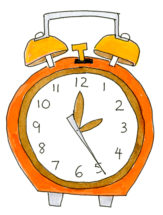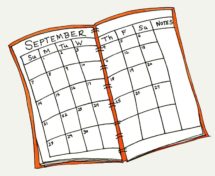My August was an intense month of working with families getting ready for the new school year. For weeks I was seeing six, seven, or even a couple of times, eight families in a day. Late in week three, Madeline caught up with me in a lull and asked me how I was holding up? I sat down and told her, “You know, to be perfectly honest I can’t remember when I’ve had so much fun.”
 I was having the time of my life with those children and their parents, teaching them about their brain and time. Every day I could see their self-awareness expand. I could see family communication improve. I got to see them begin to use strategies, especially the knowledge to calm the “bully in the brain” to stop conflicts from escalating. They were showing off their watches, their planners, the forms they had created, and their folders full of sticky notes representing their plans to tackle personal projects. Wounded learners were going out the door with their heads held high. They felt armed and ready to improve their time management skills to create a better school year than the last one.
I was having the time of my life with those children and their parents, teaching them about their brain and time. Every day I could see their self-awareness expand. I could see family communication improve. I got to see them begin to use strategies, especially the knowledge to calm the “bully in the brain” to stop conflicts from escalating. They were showing off their watches, their planners, the forms they had created, and their folders full of sticky notes representing their plans to tackle personal projects. Wounded learners were going out the door with their heads held high. They felt armed and ready to improve their time management skills to create a better school year than the last one.
Their comments delighted me. A mom left the table thanking me for “changing all our minds.” A young fifth-grader proudly checked in that his metacognition was getting better. “I’m beginning to think about making choices. I’m not making better choices, but at least I’m thinking about them!”
And then there was that priceless gem when a student taught me something I’d never thought of before. He is a wonderful bright guy going into his last year of high school but his immature executive functioning skills had been getting in his way. They were causing him and his family frustration, thwarting him from reaching his true potential. This student was so ready for the Seeing My Time course. Each session we met he was reporting success and progress. He was even making great strides on his common college application so he would be ready for early decisions.
But what made me think, “Duh, how did I miss that?” was his personal assignment when checking out at the end of a session. He wrote: “I need to get better at using all of the tools and strategies simultaneously. They are more powerful used together than they are individually.” 
Whoa! I instantly realized that I never put that together before. People often begin using one or two of the time tools: analog clocks, timers, planning forms, etc., and they stop there, satisfied with the spike of improvement experienced. But using them ALL together?
Of course, that is exactly what I do. Every day I use all the time tools to support my aging time-challenged brain. That’s how I got through the month of August. Yes, I was “done” at the end of each day, but I had things under control and was able to be charged up for the next day. Using all my tools together is how I continue to amaze myself with what I can accomplish.
Look again at the time tools you are using. What can you add to give you more control of your brain and time management? More control creates opportunities for satisfaction, relationships, purpose, less stress, and more fun!

